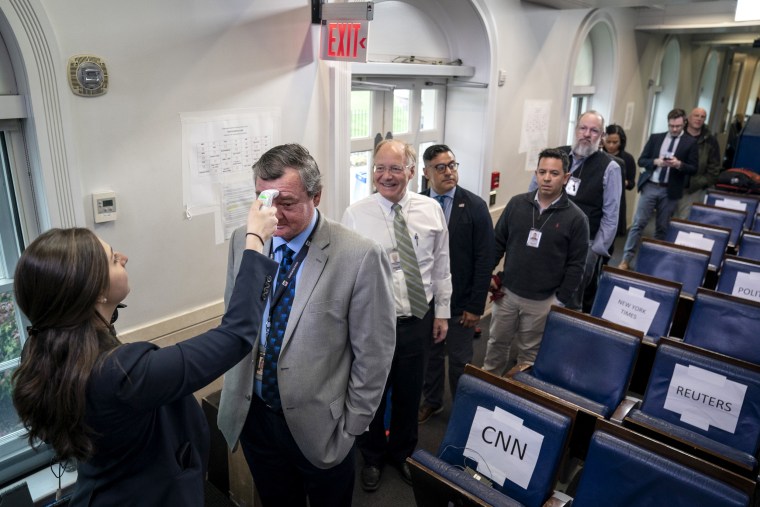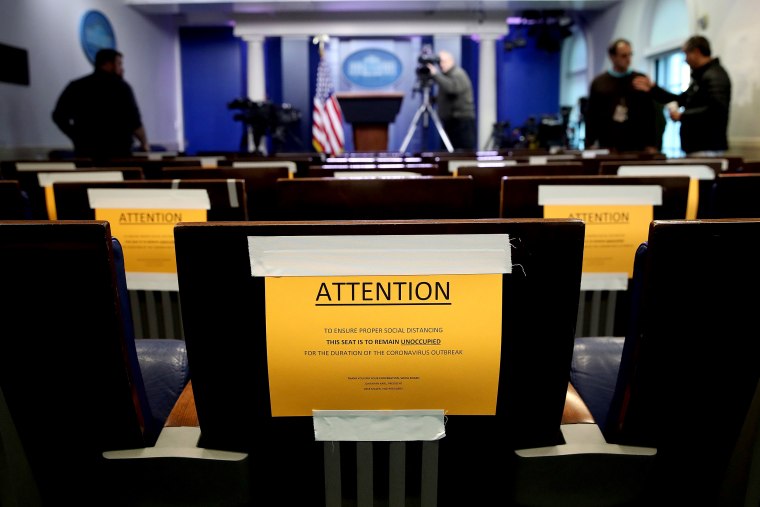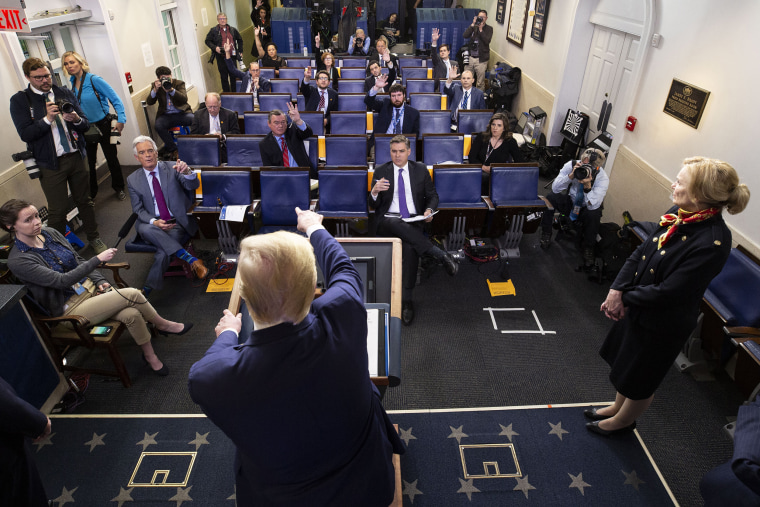WASHINGTON — There was a knock on our NBC News workspace door at the White House. I first assumed it was a colleague or a press aide coming by with an update. Instead, it was a White House official I'd never seen before with a forehead thermometer in his hand.
He had come to take my temperature before I could go into the White House briefing. The first reading he took was high; I'd been sitting by a heater at my desk for the past hour, but still my heart started to race. Several panic-inducing seconds later, I passed and was given a round, orange sticker to wear indicating I was allowed into the briefing room.
It was the third time my temperature was taken that day, the earlier two in a makeshift white tent set up outside the gate to the White House grounds.

It was all just part of the strange new reality of covering the White House amid a pandemic that officials have predicted could kill 100,000 to 240,000 Americans.
A few minutes later, I headed to the briefing room. Back in the days before the daily briefings ended over a year ago, the events were standing-room-only and the space would start to fill up an hour before it was scheduled to begin. People lacking designated seats clogged the aisles. Getting to my assigned seat was like trying to squeeze to the front row of a rock concert. I'd often go out early just to avoid the crush.
But today I waited until the very last moment.
I wanted to spend as little time as possible outside NBC's enclosed workspace. And there would be no fighting for space, because the White House Correspondents' Association has limited the number of reporters who can attend the briefing to follow social distancing guidelines.
There is no standing in the aisles allowed and every two seats are empty, with reporters on a rotation of when they can attend. A reporter from One America News, a conservative-leaning television network, was banned from future briefings by the White House Correspondents' Association because she twice violated the policy by standing in the back of the room.
News organizations also have cut back on the number of reporters coming to the White House. The press area adjacent to the West Wing, usually filled with camera operators hauling around equipment and reporters working from the briefing room chairs, was empty until the briefing was about to begin.
The closet-sized, windowless room where the NBC News White House unit works is also starkly different. On a typical day, there would have been four reporters and producers crowded together less than a foot apart, with a fifth person sometimes perched on a stool as people rotate in and out during the day.
Now, my colleagues and I are there from 6 a.m. to after 7.p.m., leaving the space only to go to the camera on the White House North Lawn or to the bathroom (for which there is no longer ever a line). We almost obsessively sanitize our hands and wipe down every surface each time we enter and exit the workspace.
And our working conditions are not the only reflection of the new reality. There's also the subject on which we report day in and day out.

At Tuesday’s coronavirus task force briefing, I sat less than a dozen feet away from President Donald Trump as he warned America we are about to go through a "very painful" few weeks. That was a turnabout after he downplayed the threat for weeks. Dr. Deborah Birx detailed how 100,000 to 240,000 Americans are expected to die within a few weeks, showing charts and graphs laying out the grim trajectory.
It was the most somber I have seen Trump in the scores of times over the past three years that I’ve been in question-and-answer sessions with him in the Oval Office, on Air Force One, from the White House North Lawn or in formal press conferences and speeches.
I have also been through a number of unprecedented moments with many of the reporters in that briefing room, and I could feel the weight of the information being presented settle over all of us, knowing how many Americans were at home watching and depending on the 14 of us in the room to get them the answers to the questions they needed.
It was a dramatic swing from the mood at the briefing the day before, which felt at times like an infomercial. The CEO of My Pillow stood at the lectern, and the president sparred with reporters, at one point displaying a new testing device like a Home Shopping Network presenter.
By the time I left at 7:30 p.m., 14 hours after arriving that day, it almost felt like my normal routine for a moment — the White House glowing in the night, a reporter doing a television hit and the regular rhythm of Secret Service agents moving about.
But as a man wearing a mask rode past me on his bike on Pennsylvania Avenue and I embarked on a 30-minute walk home to avoid taking the bus, I quickly returned to my new reality.

